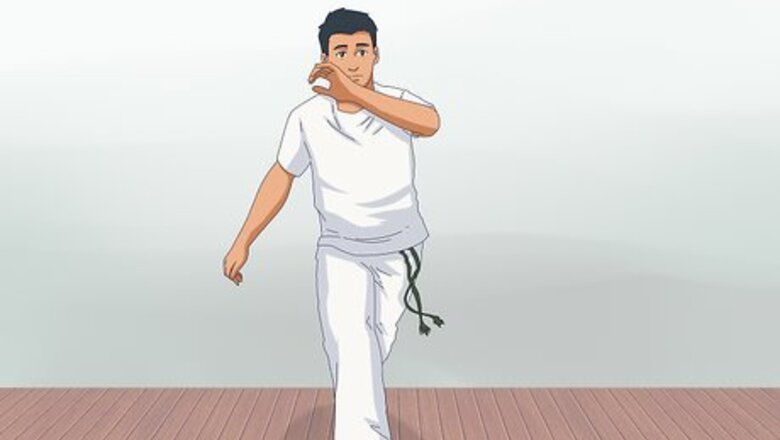
views
Practice the "ginga" to dodge or swing.
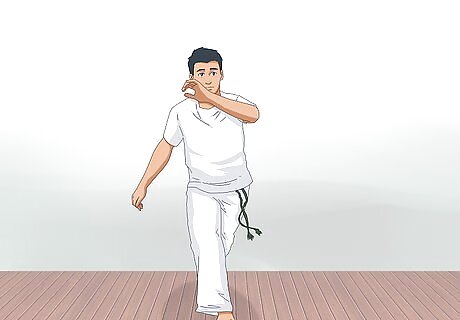
Step to the side or pretend to strike with the "ginga." For a beginner's ginga, step back and cover your face with your opposite arm. Then, adjust your position so both your legs are parallel. Step back with your alternate leg and cover your face again. To perform a fluid ginga, concentrate on your coordination and footwork. With each step of the ginga, remain light on your feet as you shift your weight from side to side or forward and back. Swing your arms to not only dodge or feign an attack but also maintain your balance the entire time you perform a ginga.
Work on your "esquiva lateral" to dodge attacks.
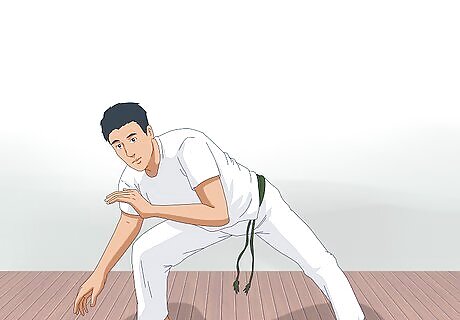
Lean to the side with an "esquiva lateral" to avoid a strike. Stand so your feet are slightly more than hip width apart and squat. To block yourself, bring your chest to your left knee if you're attacked from the right or to your right knee if someone strikes you from the left. To remain stable and prevent yourself from falling, reach back and place your palm on the floor to support your weight. To return to a balanced and centered position, use your hand to push off the ground while generating power through your legs—this will help you stand upright again.
Perform a "negativa normal" to avoid strikes or kicks.
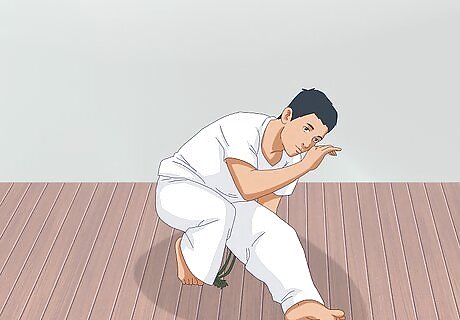
Crouch with a "negativa normal" to protect your upper body. To avoid an attack directed at your face or your chest, quickly crouch down so one of your legs is bent and the other is stretched out in front of or behind you. Stabilize yourself by keeping one hand flat on the ground as you block a strike with your opposite arm. To transition from a ginga into a negativa normal, move your back leg in front of you while bending the opposite leg and then ease yourself into a crouching position.
Focus on your “au” to avoid kicks from your attacker.

Perform this special cartwheel to evade an opponent’s kicks. Start by pointing one foot forward and turning your other foot so it's at a 45 degree angle. Lean toward the foot at the 45 degree angle and roll into a cartwheel while you keep your arms and legs fully extended. After you practice and perfect the au, you’ll build more strength and be more ready to perform a “bananeira,” a type of handstand—use it to lean forward and enter a fight or to lean backward and exit one.
Learn the “chapa” to deliver a powerful kick.
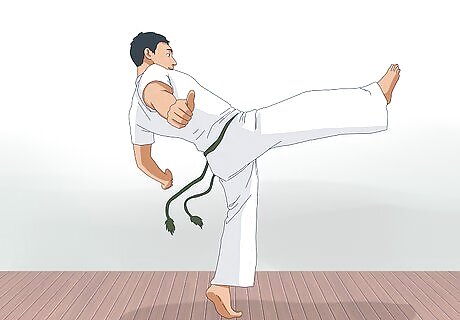
Throw this capoeira kick to push your attacker away. To begin this move, bring your knee up to your chest. Then, pivot to face your opponent. Rotate your raised leg and drive through your heel to perform your side kick. Generate as much power as possible so you can push your opponent away with your chapa. Since your attacker might think you’re just blocking an attack, you can use the element of surprise to your advantage and catch them off guard when you kick them with a “chapa.”
Try out a “queixada” to strike your opponent’s face.

Aim for your attacker’s jawbone with this forceful kick. Start by crouching with a slight bend in the knees. Lift one leg and extend it outward and up to target your opponent's face. This move is intended for experienced capoeiristas—capoeira fighters—who plan to deal a lot of damage. When you kick with the “queixada,” skip on your back foot to maintain your balance while you drive your front leg up.
Stretch your muscles regularly.
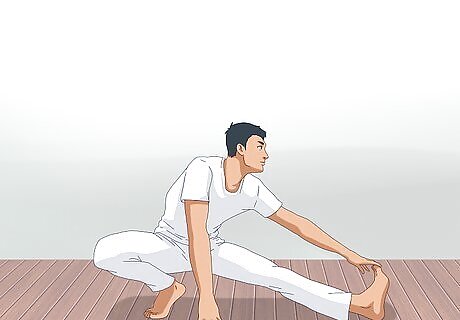
Improve your flexibility to prepare for kicks, dodges, and strikes. Stretch often, including before and after capoeira training sessions. Focus on stretching your shoulders, back, and neck first. Then, stretch out your knees and legs so you can perfect basic kicks. Spend about 10 minutes warming up before and after your capoeira training sessions.
Add strength training to your capoeira routine.
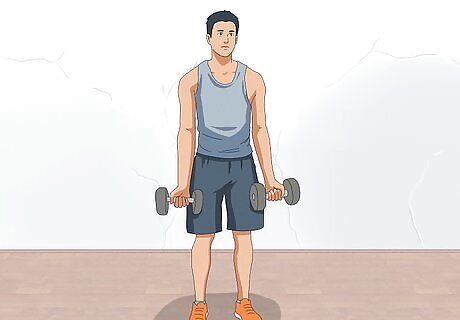
Build strength and improve your martial arts by lifting weights. Try bicep curls with a dumbbell to enhance your upper body strength. Try to do a set of 14-22 curls with the heaviest dumbbell you can fully lift. By the end of your workout, you should feel a slight burn in your arms. As you grow stronger, increase the weight of your dumbbell in 5 lb (2.27 kg) increments. Try weightlifting with a bench press so you can lift heavier loads and target more muscles at one time. Work out on a pull-up bar. Aim to do at least 5 pull-ups when you start out. As you grow stronger, try to add 1 pull-up to your routine each week.
Train with a friend.
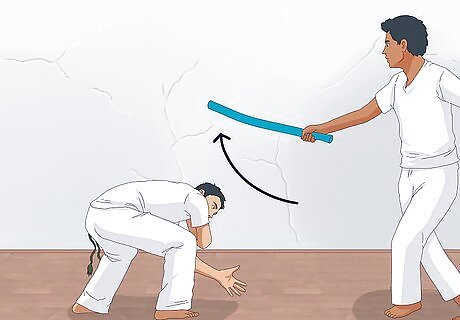
Work with a partner to improve your reflexes. Arrange a training session where your partner will launch friendly attacks with foam sticks. Try to deflect or dodge their blows. Then, ask your partner to do “pad work” with you by placing large, flat pads over their hands and swinging at you. As they swing at you, strike at the pads. To strike the pad properly, act fast and adapt quickly to your partner’s random movements. You can also build your reflexes on your own. For example, you can punch a double end-punching bag. Since it will swing back and forth when you hit it, you’ll be able to practice your dodges and your strikes.
Find a capoeira academy to take lessons.

Remember, capoeira is meant to be shared and practiced with others. Search online for local capoeira academies. If none exist near you, look for university clubs or associations which host friendly tournaments, group training opportunities, or games. Watch the more experienced players. Pay close attention to not only your mestre’s moves and instruction, but also the moves of senior capoeiristas for ideas about how to link your movements in a fluid way.
Join some capoeira matches.
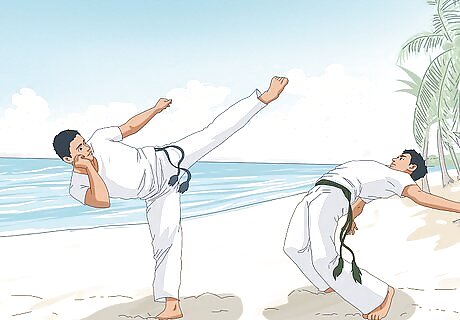
Once you’ve trained enough and feel ready, participate in the “roda.” The “roda” is where capoeira matches take place. Face off against others who are at a similar skill level as you are. To fully "interact" in the roda and excite the audience, use the element of surprise against your opponent and perform fluid movements that are in rhythm with any live music played. Don’t look at the ground when you fight. Instead, keep your eyes up and on your opponent. Watch your opponent's moves and adapt appropriately. For instance, if your opponent comes at you with a leg sweep, jump back. Move in with your “ginga,” or dance step, for a quick strike. Don’t freeze up in the roda. React with moves you know well, whether its a simple ginga, a negativa—a crouch—or a kick. If you can, record your matches. You can pause and slow-mo these videos to see what you need to improve on.


















Comments
0 comment